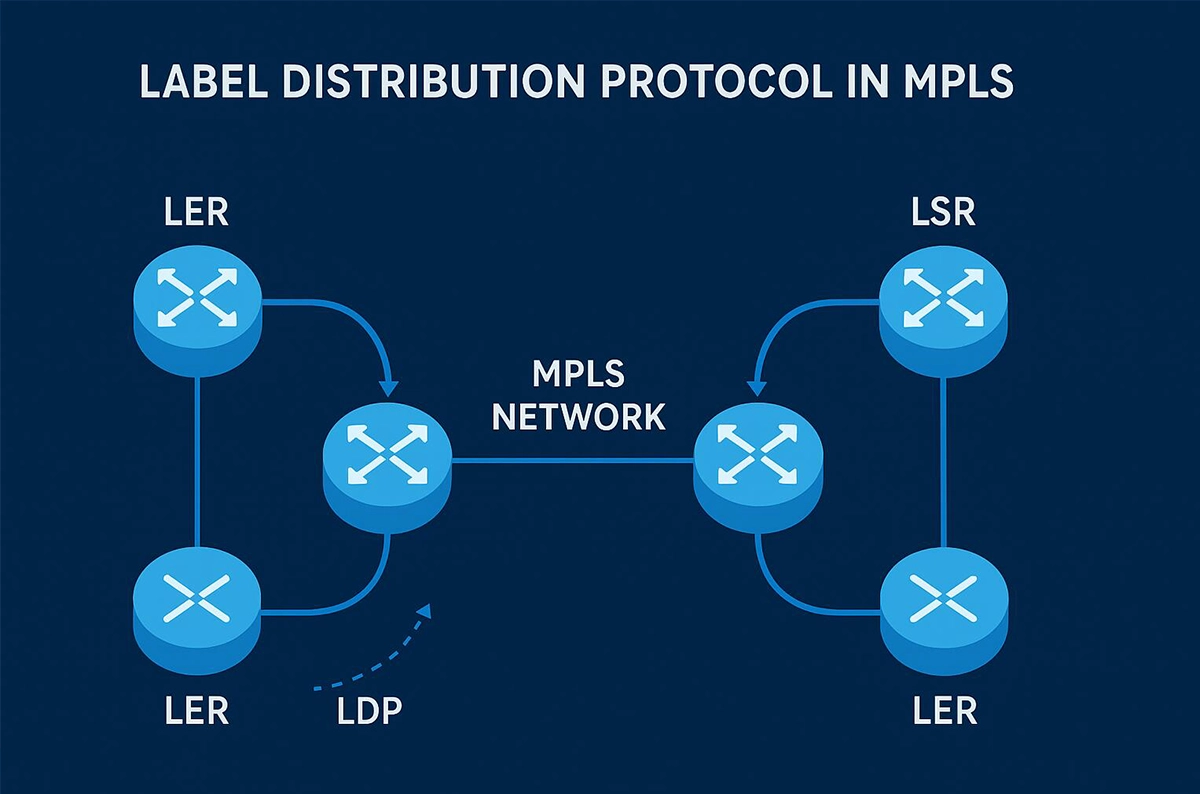
🔹 What Is LDP?
LDP (Label Distribution Protocol) is a control protocol used in MPLS (Multiprotocol Label Switching) networks to automatically assign and exchange labels between routers.
Instead of relying solely on traditional IP routing, MPLS uses short, fixed-length labels to forward packets efficiently through pre-established paths known as Label Switched Paths (LSPs).
Through LDP, routers — specifically Label Switch Routers (LSRs) and Label Edge Routers (LERs) — can dynamically communicate label mapping information, forming a virtual circuit-like path across the MPLS backbone.
🔹 How LDP Works
1. Discovery and Session Setup
Routers discover neighboring LSRs by exchanging LDP Hello messages.
Once a connection is established (typically using TCP port 646), they form an LDP session to exchange label information.
2. Label Mapping and Advertisement
Each LSR associates a local label with an IP prefix from its routing table — for example:
10.10.0.0/16 → Label 102
These label mappings are advertised to neighbors, allowing them to build a consistent Label Forwarding Information Base (LFIB).
3. Label Switched Path Creation
When each router receives label information from its peers, it builds the label stack needed for packet forwarding.
This process forms a complete Label Switched Path (LSP) from ingress LER to egress LER, enabling packets to travel through the network without repeated IP lookups.

🔹 LDP vs RSVP-TE: Understanding the Difference
Feature | LDP | RSVP-TE |
|---|---|---|
Path Control | Based on the IGP shortest path | Explicitly defined by the administrator |
Traffic Engineering | No | Yes |
QoS / Bandwidth Reservation | Limited | Supported |
Complexity | Simpler | More complex |
Use Case | General MPLS forwarding | Backbone traffic optimization |
While LDP provides a simple and scalable way to establish label paths, RSVP-TE (Resource Reservation Protocol - Traffic Engineering) allows more advanced control, such as bandwidth reservation and QoS enforcement in large carrier networks.
🔹 Types of LDP
▷ Basic LDP (Hop-by-Hop LDP)
Labels are assigned based on IGP routing information (OSPF, IS-IS).
Each hop independently determines the next label, forming a best-effort LSP.
▷ Targeted LDP (tLDP)
Used to establish LSPs between non-directly connected routers.
It’s essential for MPLS Layer 2/3 VPNs, where label exchange happens between remote edge routers.
🔹 Advantages of Using LDP
Automated label management — no manual configuration required
Interoperability — supported by all major vendors (Cisco, Juniper, Huawei)
Efficient scaling for large MPLS backbones
Low latency and predictable performance for enterprise and service provider environments
🔹 LDP’s Role in Modern Networks
LDP underpins many real-world MPLS applications, including:
Service Provider Backbones for high-speed IP/MPLS routing
Carrier Ethernet and Metro Networks
Traffic Segmentation in cloud and enterprise networks
By ensuring reliable label distribution, LDP enables deterministic, high-performance packet forwarding — a foundation of today’s converged IP and optical infrastructures.
LINK-PP’s Role in LDP-Enabled MPLS Systems

LINK-PP’s high-performance optical transceivers, Ethernet magnetics, and RJ45 integrated connectors provide the robust physical infrastructure that enables MPLS and LDP-based routing systems to achieve low-latency, high-throughput data exchange across enterprise, telecom, and data center networks.
Engineers deploying MPLS routers or edge switches rely on LINK-PP components to ensure:
Signal integrity for high-speed optical and electrical interfaces
Low insertion loss and EMI performance for stable data links
Long-term interoperability with leading networking equipment vendors
🔗 Explore LINK-PP Optical Transceivers and RJ45 Connectors
🔹 Conclusion
LDP (Label Distribution Protocol) remains the backbone signaling protocol for MPLS networks, ensuring efficient label management and scalable forwarding performance.
By simplifying label distribution between routers, LDP enables the creation of high-speed, low-latency Label Switched Paths (LSPs) — the essential mechanism behind modern IP transport networks.
With LINK-PP’s optical transceivers and RJ45 connector modules, network engineers can design MPLS systems that deliver maximum reliability, throughput, and flexibility for global-scale applications.


